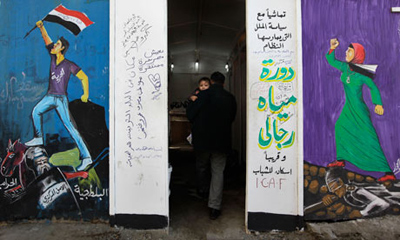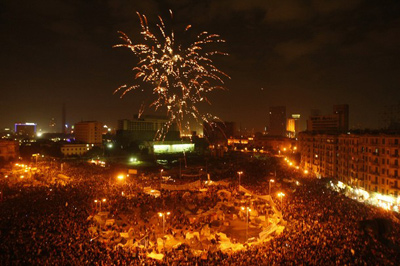On images, voices and information – a media approach to the Egyptian revolution
No revolution just happens from one minute to the other, out of the blue. In retrospect, one can pinpoint a lot of incidences (and art works), that prepared a revolution.

Revolutionary murals on the walls of newly established toilet facilities for protesters in Cairo’ s Tahrir Square. Photography by Ben Curtis/AP, February 2011
But the spark that is needed to bring hundreds of thousands, millions of people of different backgrounds and walks of life together for one goal, toppling the ruler, overthrowing the government, is not to be predicted. The paths revolutions lead to are also unforeseeable. Transitional periods (Is there anything else than transitional periods? Even if the transitional period lasts for decades and centuries, challenging patience?) can be long-lasting, full of uncertainties, doubts, worries and - utopias; definitely a lot of work, demanding patience, endurance and activities.
The revolutionary attempts this year in Arab countries were apparently ignited by a 26-year-old vegetable vendor in Tunisia, sustaining his family in Sidi Bouzid, a town with approx. 40,000 inhabitants. The licensing of his stand was repeatedly refused. On 17th December 2010 he was ready to pay the fine of $7US, a day’s wages; but the policewoman in charge spat at him and verbally insulted him. A couple of hours later, he set himself on fire and died in hospital on 4th January 2011.
Though images of him actually setting himself on fire are missing. But we can watch and witness the reactions of the people in his hometown and across the country. Still, the image of a vendor setting himself on fire in front of the provincial headquarters became an image, triggering copy cats in Egypt and in Saudi Arabia. The image becomes symbolic. Information becomes image. Image becomes information.
Despite the fact, that the Egyptian government blocked the Internet, mobile phones and landlines during the first days of the revolution, information spread like wildfire, locally and globally.
When they were banned from filming themselves, their offices searched and closed, the international media broadcasted audio-visual snippets provided by “amateurs” (…the source of this video could not completely be verified….) and people were interviewed anonymously on the phone to protect their safety.
Electronic communication went back to normal, landlines operating, the Internet became a fertile canvas for logistic support. (We might also speak of an emotional support.); electronic communication tools served as a platform of information.
The people at Midan Tahrir generated multiple identities, as activists, protesters, participants, citizens, supporters, witnesses, documentarists, reporters. Besides using words, it seemed to be possible to influence and maybe even control images and words informing the “others” and themselves about what was really happening, - beyond official information policies.
Being able to build on the experience of years of intensive individual blogging (for a mutual course) and more recent Facebook groups, (e.g. the April 6th Youth Movement, 2008; We Are all Khaled Said, 2010), electronic platforms were eagerly accepted and used with a proud implicitness.
These outputs, spatial and contentual achievements progressively shape an enormous hybrid carpet of visuals and sounds (all information) that is (still) overwhelming.

Some images and sounds became iconic. Symbolic.
Tahrir Square, 11th February 2011, Cairo, Egypt
Before we delve into some images and sounds (all information) created by the revolution in Egypt, I want to show you a short film standing for other countless images (and words), which prepared for the revolution in the past.
The Chair Carrier, 10.32 min, shot in 2010, was named Best Satire Film in October 2010 at the American International Film Festival (AIFF) and the Silver Award at the “Student Film Competition” of the California Film Award.
The film The Chair Carrier is an adaptation of a short story by Egyptian author Yusuf Idris, written in 1970, the year of a ceasefire marking the end of the War of Attrition between Israel and Egypt, and the year of Gamal Abdel Nasser’s death.
Idris (1927-1991) is one of the pioneering Egyptian writers who produced many plays, short stories and novels. Having supported the rise of Gamal Abdel Nasser, he disappointedly withdrew from his ideas in 1956. The Chair Carrier is a satire on political life in Egypt.
The filmmaker, Tarek Khalil, born 1976 in Egypt, uploaded his film on YouTube 29th, January 2011.
In the following days, a lot of videos, images/voices, created by the revolution and influencing the revolution, were uploaded. Three of these symbolic images/voices - standing for many others, comprise various aspects of the Egyptian society and its revolution.
Here, the dramaturgy of their appearances is given by the date of their release on TV and Internet, each having a meaningful impact and echo in their very time (and beyond):
An appeal by Asmaa Mahfouz, posted on YouTube, 1st February 2011
Born in 1985, Asmaa Mahfouz is an Egyptian activist, co-founder of the April 6 Youth Movement* and member of the Youth of the Revolution.
*The April 6th Youth Movement is an Egyptian Facebook group founded in spring 2008, supporting the call for a nation-wide strike, after textile workers went on strike in the Egyptian city, El-Mahalla El Kubra, in the Nile Delta.
Under the slogan: Stay at home to speak out, they demanded a.o. the following:
1- Minimum monthly wage of 1200 Egyptian pound (about $210)
2- Stabilization of wages
3- Election of a constituent assembly to draft a new constitution to guarantee the country’s political and trade union freedoms and to set a maximum of two terms for any president to stay in power.
and still ongoing
What a surprise to find myself sitting in front of two computer screens, witnessing and watching the Egyptian revolution, hours and minutes and days and nights on end. No smell. But sound. And words. And images.
On blogs, on-line TV-streamings, news, - papers, breaking news, interviews; complete coverage, pretending to offer immediate, time-based participation as well as instant analyses, prognoses; sometimes open to surprises. No smell. Guessing the atmosphere.
There were gabs. Gabs of detachment from a place I know well, people I know well, the food, the habits, the drinks and the streets, the dust and the trees. Sometimes these gabs interfere with other references, images blanket images, sounds blend.
The profession of a war journalist has long been established. With the invention of the photo camera, battle paintings were redeemed. War radio, embedded journalism, life coverage. This was a televised revolution; one to one imagery. This was something new.
How new old can be, shows the last video clip The Revolution Will Not Be Televised, (…..primarily because it won’t be), 1970 by Gil Scott Heron, April 1, 1949 – May 27, 2011. Listen to his reasons:
written and compiled by Rayelle Niemann, Zurich, January, February + June 2011
ANOTHER PROJECT ON CITYSHARING
→ Leading a Smart Revolution
RELATED WEB SITES
→ Tahrir Archive
→ revolution media archive
[ Arab Army ]
[ Coincidental Destinies ]
[ MODERN LEAVES ]
[ Moving on – Moving back – Moving on ]
• On images, voices and information – a media approach to the Egyptian revolution •
[ Setting ]
[ Tahrir Square: Social Media, Public Space ]
[ Tank Man Tango ]
[ War Tourist ]
FEATURED THEME ON CITY SHARING
by ASUNCION MOLINOS GORDO
-
This project is an instrument for common critical analysis to help understand the reasons behind Egyptians’ diminishing …
by INAS HALABI
-
The project Letters to Fritz and Paul focuses on the expeditions of the Swiss cousins, lovers and scientists, Fritz and …
by SARAH BURGER
-
The planned modern city of Brasilia attracted me since a long time. Her defined shape, location and function proceded he …
by ADRIEN GUILLET
-
Youri Telliug talks with the artist Adrien Guillet about his project Citracit
Youri Telliug - What is Citracit …
by NIGIST GOYTOM
-
In 2013 more than 45 million people have been forced to leave their homes. This amounts to the biggest number of refugees …
by SULAFA HIJAZI
-
The on going debate on Arab identity and its (cultural) representation is strongly shaped by Edward Saidʼs formative …
by ASUNCION MOLINOS GORDO
-
WAM is a site-specific work that uses the historical trope of the cabinet of curiosities to explore the introduction of …
MORE CONTRIBUTIONS BY THE FOLLOWING